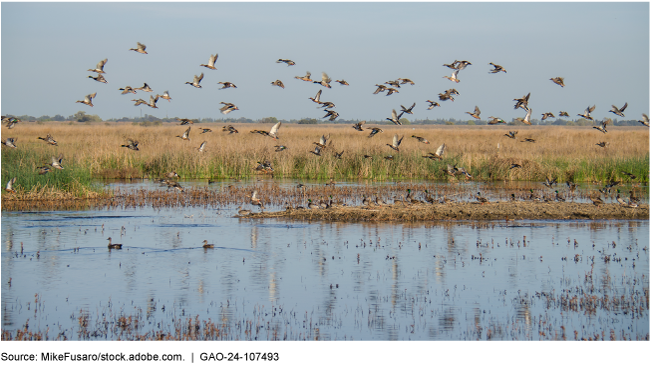Clean Water Act: Costs of Compensatory Mitigation Activities for Losses of Aquatic Resources
Fast Facts
Wetlands, streams, and other aquatic resources are critical to healthy ecosystems. People who are dredging or doing other work that may damage these aquatic resources generally must get a permit. Federal permits may require permittees to offset the damage. Permittees may do the work themselves or buy credits from a third-party agency, company, or organization that will preserve or improve wetlands elsewhere.
This Q&A report looks at the costs of this kind of offsetting. State and federal officials told us they didn't break out these costs from other spending. Information on permittees and third-parties' costs isn't always publicly available.

Highlights
What GAO Found
Wetlands, streams, and other aquatic resources are critical to maintaining healthy ecosystems. Wetlands support a number of valuable functions, including controlling floods, improving water quality, and providing wildlife habitat. To restore and maintain the integrity of these waters, discharge of fill and dredge material into waters of the U.S. is generally prohibited without a permit from the U.S. Army Corps of Engineers (Corps). These permits, authorized by section 404 of the Clean Water Act, can require responsible parties to provide compensatory mitigation to offset unavoidable adverse impacts of their projects on aquatic resources. Compensatory mitigation refers to the restoration, establishment, enhancement, or—in certain circumstances—preservation of wetlands, streams, and other aquatic resources for the purpose of offsetting unavoidable adverse impacts that remain after achieving all appropriate and practicable avoidance and minimization. Permittees may perform such work themselves (known as permittee-responsible mitigation) or purchase credits from third-party mitigators that improve or preserve wetlands or other aquatic resources and assume responsibility for successful completion of the mitigation project.
Certain federal agencies and state environmental agencies incur costs for reviewing and approving third-party mitigation projects and reviewing monitoring reports for those projects. For example, the Corps incurs staff time costs for reviewing permit applications and monitoring implementation of the mitigation. The Corps and the Environmental Protection Agency also incur costs for activities such as developing compensatory mitigation policy.
Costs are incurred for (1) design and approval, (2) land, (3) site work, (4) maintenance and monitoring, and (5) long-term stewardship. For example, according to third-party mitigators GAO spoke with, the cost to acquire the land where the mitigation will be performed is one of the most significant drivers of third-party mitigation credit prices, but these costs can be highly variable.
Federal and state agencies include the costs they incur for compensatory mitigation activities as part of other agency expenditures and do not track these costs separately. In addition, cost information for third-party mitigators and permittees is not always publicly available.
Why GAO Did This Study
Parties with permits to discharge fill and dredge material into waters of the U.S. may be required to offset unavoidable adverse impacts to aquatic resources through compensatory mitigation activities. The Water Resources Development Act of 2022 includes a provision for GAO to review costs of carrying out compensatory mitigation activities borne by the federal government, a permittee, or any other involved entity. This report discusses the types and amounts of costs for carrying out such activities borne by the federal government, third-party mitigators, section 404 permittees, and any other involved entities, such as state government agencies.
GAO interviewed officials from six federal agencies and two states, representatives from two third-party mitigation programs, four industry and environmental research groups, and one academic researcher. GAO also conducted literature searches to identify studies that discuss compensatory mitigation activities and related costs.
For more information, contact Cardell Johnson at (202) 512-3841 or JohnsonCD1@gao.gov.
